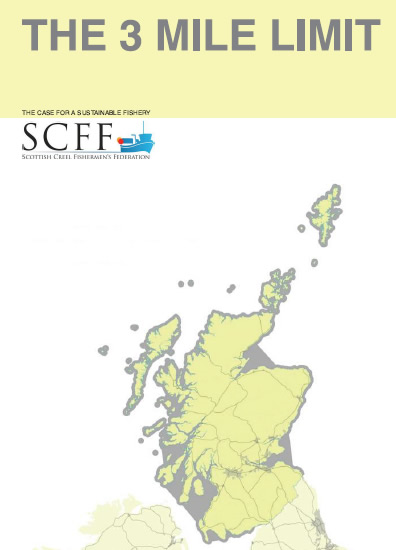3 Mile Limit - A Case for a Sustainable Fishery
The three mile limit - full
proposal, click here
This document is an attempt to inform and promote to fishermen and fisheries
managers the fact that reinstatement of the three mile limit is not just
possible or plausible, but is presently the best chance we have of preserving
and allowing some recovery of our inshore fisheries for the future. Furthermore
it is entirely affordable.
The three mile limit was in place for the bulk of the 100 years preceding 1984.
Since its removal, almost all the remaining demersal/finfish species, previously
commercially exploited within inshore waters, have been reduced to commercial
extinction, the bulk of the inshore fleet are now mainly reliant on nephrops and
scallop fisheries.
The decline in the inshore fishing fleets working from Scottish west coast ports
has been quite dramatic, with many ports now only serving a small fraction of
the fishing vessels of just a decade or two ago. The ecosystem, the fisheries
and employment opportunities in the inshore waters within 3 miles of land have
deteriorated considerably since the opening of those waters to trawling.
The east of Scotland has a significantly different geography and distinct
fisheries from those on the west. Much of the east coast static sector is based
around crab and lobster fisheries and a more significant percentage of those
static fisheries are based further offshore than three miles. It is for those
reasons that this document aims to focus on the west coast and many of the
options considered herein will not be applicable or appropriate to the east
coast inshore fleet.
Introduction
It is the sincere belief of the authors that it is possible to substantially
improve the health of our inshore ecosystem and our inshore fishing industry in
a relatively short space of time and with relatively little effort. The
improvement could be so substantial as to double the amount of fishermen
employed inshore, double the amount of vessels operating inshore and double the
revenues generated from the area. Remarkably we think it is possible to do all
this without increasing the present catch, and do so with substantially less
environmental footprint. Further still the implementation of this proposal would
simultaneously reduce the bethnic disturbance, discard and by-catch ratios for
those fisheries to practically zero.
The mechanism that may be able to realise those remarkable achievements is the
reinstatement of the former three mile limit (or a close variation of it).
Other significant benefits from reinstating the 3 mile limit include the ability
to address, solve or mitigate gear conflict between the static and mobile
sectors, accommodate the expansion of the creel sector, remodel fishers
relationship and interactions with MPA’s, create protection of inshore nursery
grounds for vulnerable finfish (amongst other species) and disrupt less of the
ecosystem services provided by benthic habitats. It will also become possible to
successfully implement other fisheries management measures that cannot be
realised in mixed gear Nephrops fisheries (e.g. increasing the MLS of nephrops,
returning berried prawns etc.). Most importantly for fishermen it can achieve
this whilst maintaining and promoting vibrant diverse and healthy fishing
communities.
Applicability
The primary focus of this document is the inshore west coast Nephrops trawl and
creel fisheries, however those fishing grounds and the communities that depend
on them are also shared by scallop, dredge and dive fisheries as well as
significant crab and lobster fisheries and other smaller scale fisheries
interests like commercial angling, whelk and razor fishers. Furthermore there is
significant historical evidence that there were once substantial demersal fin
fish fisheries along the entirety of the Scottish west coast, it is our belief
that they will also be positively affected by the proposal.
The Evidence
There are some who dispute the impacts of mobile trawl and dredge fisheries, and
many who consider bottom contact mobile gears as analogous to ploughs on land.
Regardless of your position on the nature and impacts of mobile gears, the
evidence for some of their long term effects is clearly demonstrated in the
historical record.
Again there are some who argue creel fishing could also become unsustainable, we
demonstrate that there is sufficient evidence to show that, with a well
regulated static gear fishery, both the fishermen and the environment would
benefit from a transition from mobile to static gears within the 3 mile inshore
zone.
When all else is considered, reinstatement of the three mile limit is the only
plan on the table which addresses the present decline in the inshore sector and
offers the likelihood of long term stability and sustainability for the inshore
fisherman. The three mile limit manages to address many of the big, otherwise
insurmountable, issues presently facing our environment and our industry, like
the commercial extinction of most inshore demersal fish species, and the decline
in catch per unit of effort within the remaining nephrops and scallop fisheries.
For full report, please click
here or on image below:

| 
